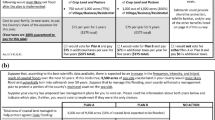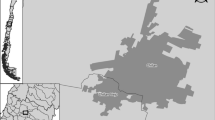Abstract
A latent-class model of environmental preference groups is developed and estimated with only the answers to a set of attitudinal questions. Economists do not typically use this type of data in estimation. Group membership is latent/unobserved. The intent is to identify and characterize heterogeneity in the preferences for environmental amenities in terms of a small number of preference groups. The application is to preferences over the fishing characteristics of Green Bay. Anglers answered a number of attitudinal questions, including the importance of boat fees, species catch rates, and fish consumption advisories on site choice. The results suggest that Green Bay anglers separate into a small number of distinct classes with varying preferences and willingness to pay for a PCB-free Green Bay. The probability that an angler belongs to each class is estimated as function of observable characteristics of the individual. Estimation is with the expectation–maximization (E–M) algorithm, a technique new to environmental economics that can be used to do maximum-likelihood estimation with incomplete information. As explained, a latent-class model estimated with attitudinal data can be melded with a latent-class choice model.
Similar content being viewed by others
References
Aldrich, G., K. Grimsrud, J. Thacher and M. Kotchen (2005), Relating Environmental Attitudes and Contingent Values: How Robust are Methods for Identifying Heterogeneous Groups?
P. Arcidiacono J. Jones (2003) ArticleTitle‘Finite Mixture Distributions, Sequential Likelihood, and the EM Algorithm’ Econometrica 71 IssueID3 933–946 Occurrence Handle10.1111/1468-0262.00431
K. Bandeen-Roche D. L. Miglioretti S. L. Zeger P. J. Rathouz (1997) ArticleTitle‘Latent Variable Regression for Multiple Discrete Outcomes’ Journal of the American Statistical Association 92 IssueID440 1375–1386 Occurrence Handle10.2307/2965407
D. Bartholomew M. Knott (1999) Latent Class Models and Factor Analysis EditionNumber2 Oxford University Press Inc. New York
M. Ben-Akiva M. Walker A. Bernardino D. Gopinath T. Morikawa A. Polydoropoulos (2002) ‘Integration of Choice and Latent Variable Models’ H. Mahmassani (Eds) In Perpetual Motion: Travel Behavior Research Opportunities and Application Challenges Pergamon, Amsterdam New York
P. Boxall W. Adamowicz (2002) ArticleTitle‘Understanding Heterogeneous Preferences in Random Utility Models: A Latent Class Approach’ Environmental and Resource Economics 23 IssueID4 421–446 Occurrence Handle10.1023/A:1021351721619
H. Bozdogan (1987) ArticleTitle‘Model Selection and Akaike’s Information Criterion (AIC): The General Theory and its Analytical Extensions’ Psychometrika 52 345–370 Occurrence Handle10.1007/BF02294361
B. Chipman L. Helfrich (1988) ArticleTitle‘Recreational Specializations and Motivations of Virginia Anglers’ North American Journal of Fisheries Management 8 390–398 Occurrence Handle10.1577/1548-8675(1988)008<0390:RSAMOV>2.3.CO;2
C. Clogg L. Goodman (1984) ArticleTitle‘Latent Structure Analysis of A Set of Multidimensional Contingency Tables’ Journal of the American Statistical Association 79 IssueID388 762–771 Occurrence Handle10.2307/2288706
L. Collins P. Fidler S. Wugalter J. Long (1993) ArticleTitle‘Goodness-of-fit Testing for Latent Class Models’ Multivariate Behavioral Research 28 375–389
N. Connelly T. Brown B. Knuth (2000) ArticleTitle‘A Multiple Market Segmentation of Great Lakes Anglers in New York’ North American Journal of Fisheries Management 20 399–407 Occurrence Handle10.1577/1548-8675(2000)020<0399:AMMSOG>2.3.CO;2
N. Connelly B. Knuth T. Brown (2001) ArticleTitle‘An Angler Typology based on Angler Fishing Preferences’ Transactions of the American Fisheries Society 130 130–137 Occurrence Handle10.1577/1548-8659(2001)130<0130:AATBOA>2.0.CO;2
L. Menezes ParticleDe D. Bartholomew (1996) ArticleTitle‘New Developments in Latent Structure Analysis Applied to Social Attitudes’ Journal of the Royal Statistical Society: Series A 159 IssueID2 213–224
A. Dempster N. Laird D. Rubin (1977) ArticleTitle‘Maximum Likelihood from Incomplete Observations’ Journal of the Royal Statistical Society: Series B 39 1–38
M. Eid R. Langeheine E. Diener (2003) ArticleTitle‘Comparing Typological Structures across Cultures by Multigroup Latent Class Analysis – A Primer’ Journal of Cross-Cultural Psychology 34 IssueID2 195–210 Occurrence Handle10.1177/0022022102250427
B. Everitt (1993) Cluster Analysis Edward Arnold London
Falconer, K. (2001), Investigation of Arable Production and Pesticide Usage Using Factor Analysis. University of Cambridge, Department of Land Economy, Environmental Series Number 1
Flachaire, E., G. Hollard and S. Luchini (2003). A New Approach to Anchoring: Theory and Evidence from a Contingent Valuation Survey. GREQAM working paper
L. Hatcher (1994) A Step-by-Step Approach to Using the SAS System for Factor Analysis and Structural Equation Modeling SAS Institute Inc Cary, NC
S. Holland R. B. Ditton (1992) ArticleTitle‘Fishing Trip Satisfaction: A Typology of Anglers’ North American Journal of Fisheries Management 12 28–33 Occurrence Handle10.1577/1548-8675(1992)012<0028:FTSATO>2.3.CO;2
C. Hurvich M. Tsai (1989) ArticleTitle‘Regression and Time Series Model Selection in Small Samples’ Biometrika 76 IssueID2 297–307 Occurrence Handle10.2307/2336663
L. Kaufman P. Rousseeuw (1990) Finding Groups in Data: An Introduction to Cluster Analysis John Wiley and Sons, Inc New York
J. Kim C. Mueller (1978a) Factor Analysis: Statistical Methods and Practical Issues Sage Publications Beverly Hills, CA
J. Kim C. Mueller (1978b) Introduction to Factor Analysis: What it is and How to do it Sage Publications Beverly Hills, CA
McClelland, E. (2001). Measurement Issues and Validity Tests for Using Attitude Indicators for Contingent Valuation Research. National Center for Environmental Economics, U.S. Environmental Protection Agency, Working Paper 2001-01
A. McCutcheon (1987) ArticleTitle‘Sexual Morality, Pro-life Values, and Attitudes Toward Abortion – A Simultaneous Latent Structure Analysis for 1978–1983’ Sociological Methods and Research 16 IssueID2 256–275
A. McCutcheon M. Nawojcyzk (1995) ArticleTitle‘Making the Break – Popular Sentiment Toward Legalized Abortion among American and Polish Catholic laities’ International Journal of Public Opinion Research 7 IssueID3 232–252
E. Morey K. Rossmann (2003) ArticleTitle‘Using Stated-Preference Questions to Investigate Variations in Willingness to Pay for Preserving Marble Monuments: Classic Heterogeneity, Random Parameters, and Mixture Models’ Journal of Cultural Economics 27 IssueID3/4 215–229 Occurrence Handle10.1023/A:1026365125898
B. Provencher K. Baerenklau R. Bishop (2002) ArticleTitle‘A Finite Mixture Logit Model of Recreational Angling with Serially Correlated Random Utility’ American Journal of Agricultural Economics 84 IssueID4 1066–1075 Occurrence Handle10.1111/1467-8276.00054
R. Scarpa A. Drucker S. Anderson N. Ferraes-Ehuan V. Gomez C. Risopatron O. Rubio-Leonel (2003) ArticleTitle‘Valuing Animal Genetic Resources in Peasant Economies: The Case of the Box Keken Creole Pig in Yucatan’ Ecological Economics 45 IssueID3 427–443 Occurrence Handle10.1016/S0921-8009(03)00095-8
R. Scarpa M. Thiene (2005) ArticleTitle‘Destination Choice Models for Rock Climbing in the Northeastern Alps: A Latent-Class Approach Based on Intensity of Preferences’ Land Economics 81 IssueID3 426–444
G. Schwarz (1978) ArticleTitle‘Estimating the Dimension of a Model’ The Annals of Statistics 6 461–464
Shonkwiler, J. and W. Shaw (2003). ‘A Finite Mixture Approach to Analyzing Income Effects in Random Utility Models: Reservoir Recreation along the Columbia River’, in N. Hanley, D. Shaw and R. Wright, eds., The New Economics of Outdoor Recreation, Edward Elgar, pp. 242–268.
J. Sullivan J. Delfino C. Buelow T. Sheffy (1983) ArticleTitle‘Polychlorinated Biphenyls in the Fish and Sediment of the Lower Fox River, Wisconsin’ Bulletin of Environmental Contamination and Toxicology 30 58–64 Occurrence Handle10.1007/BF01610099
J. Thacher E. Morey E. Craighead (2005) ArticleTitle‘Using Patient Characteristics and Attitudinal Data to Identify Treatment Preference Groups: A Latent-class Model’ Depression and Anxiety 21 IssueID2 47–54 Occurrence Handle10.1002/da.20057
D. Titterington A. Smith U. Makov (1985) Statistical Analysis of Finite Mixture Distribution EditionNumber1 John Wiley & Sons New York
M. Davier (1997) ArticleTitle‘Bootstrapping Goodness of Fit Statistics for Sparse Categorical Data: Results of a Monte Carlo study’ Methods of Psychological Research Online 2 29–48
M. Wedel W. Kamakura (2000) Market Segmentation: Conceptual and Methodological Foundations EditionNumber2 Kluwer Academic Publishers Boston, MA
K. Yamaguchi (2000) ArticleTitle‘Multinomial Logit Latent-Class Regression Models: An Analysis of the Predictors of Gender-Role Attitudes among Japanese Women’ American Journal of Sociology 105 IssueID6 1702–1740 Occurrence Handle10.1086/210470
Author information
Authors and Affiliations
Corresponding author
Additional information
Edward Morey and Jennifer Thacher are equal authors and rotate authorship across articles.
Rights and permissions
About this article
Cite this article
Morey, E., Thacher, J. & Breffle, W. Using Angler Characteristics and Attitudinal Data to Identify Environmental Preference Classes: A Latent-Class Model. Environ Resource Econ 34, 91–115 (2006). https://doi.org/10.1007/s10640-005-3794-7
Accepted:
Issue Date:
DOI: https://doi.org/10.1007/s10640-005-3794-7




